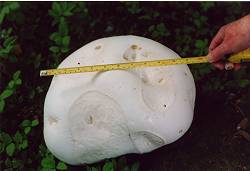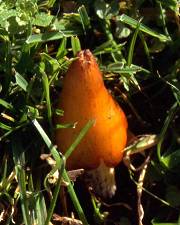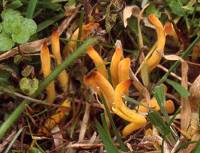This appears to have been a good year for fungi.
I say ‘appears’ since I have not had confirmation or otherwise from any
expert in this field. Neither must you
make the mistake of thinking that I am a Fungi expert.
However, I have come across species that I have not seen before. Your secretary showed me a huge puffball
growing among some trees by his house.
 This was the Giant Puffball, Calvatia gigantea. It has been known to grow to 30" across but
this one was relatively small at about 8" to 9" across. In January this year, a builder brought the
largest specimen he had found among a number growing below the floorboards in a
house in Wombleton. It measured 11 inches across.
This was the Giant Puffball, Calvatia gigantea. It has been known to grow to 30" across but
this one was relatively small at about 8" to 9" across. In January this year, a builder brought the
largest specimen he had found among a number growing below the floorboards in a
house in Wombleton. It measured 11 inches across.
Many garden plants and weeds have been attacked by yellow or orange Rusts, usually Puccinia
species and some by the white powdery mildews.
My fruit trees have suffered too with both eating apples and plums attacked by
brown rot while still on the tree. The
fruit develops numerous pinkish/brown blobs bursting through the skin due to Sclerotinia
fructigena. Bramley Seedling
cooking apples seem to be quite resistant to this particular fungus.
| Slime moulds |
|
| Tubifera ferruginosa |
on conifer stump |
| Erysiphe cichoracearum |
on C.nigra |
| Erysiphe galeopsidis |
on S.sylvatica |
| Erysiphe heraclei |
on H.sphodylium |
| Hypoxylon fragiforme |
on felled Fagus |
| Hypoxylon multiforme |
on Betula |
| Microsphaera alphitoides |
on Quercus saplings |
| Microsphaera trifollii |
on T.dubium |
| Sawadaea bicornis |
on Acer leaves |
| Sphaerotheca epilobii |
on E.montanum |
| Sphaerotheca fusca |
on L.communis |
| Xylaria carpophylla |
on Fagus mast |
| Xylaria hypoxylon |
on Fagus stump |
| Xylaria polymorpha |
on Fagus stump |
| Discomycetes |
|
| Helvella crispa |
|
| Rytisma acerinum (Tar spot) |
on Acer leaves |
| Loculomycetes |
|
| Cymadothea trifolii |
on T.repens |
| Protomyces macrosporus |
on Aegopodium |
| Venturia maculiformis |
on E.angustifolium |
| Hymenomycetes (Mushrooms & Toadstools) |
|
| Amanita citrina (False Death Cap) |
Cortinarius annomalus |
| Amanita citrina v.alba |
Cystoderma amianthinum |
| Amanita muscaria (Fly Agaric) |
Entoloma conferendum |
| Amanita rubescens (Blusher) |
Gymnopilus penetrans |
| Armillaria bulbosa |
Hygrocybe virginea |
| Boletus subtomentosus |
Laccaria laccata (Deceiver) |
| Chalciporus piperatus |
Laccaria proxima |
| Clitocybe nebularis (Clouded Agaric) |
Lactarius blennius (Slimy Milk-cap) |
| Collybia butyracea (Butter Cap) |
Lactarius fluens |
| Collybia confluens (Clustered Tough-shank) |
Lactarius tabidus |
| Collybia maculata (Spotted Tough-shank) |
Lactarius torminosus (Woolly Milk-cap) |
| Collybia peronata (Wood Woolly-foot) |
Lactarius turpis (Ugly Milk-cap) |
| Coprinus comatus (Shaggy Ink Cap) |
Leccinum scabrum (Brown Birch Bolete) |
| Leccinum variicolor |
Russula betularum |
| Lentinellus cocleatus |
Russula fellea (Geranium-scented Russula) |
| Lyophyllum conatum |
Russula mairei (Beechwood Sickener) |
| Lyophyllum decastes (Fried Chicken Mushroom) |
Russula nigrescens |
| Marasmius androsaceus (Horsehair Toadstool) |
Russula ochroleuca(Common Yellow Russula) |
| Mycena galericulata (Grey Bonnet) |
Russula puelaris |
| Mycena pura (Clean Mycena) |
Russula vesca (Bare-toothed Russula) |
| Paxillus involutus (Brown Roll-rim) |
Suillus grevillei (Larch Bolete) |
| Pluteus podospileus |
Tricholomopsis rutilans (Purple Blewitt) |
| Aphyllophorale Type Fungi (Brackets) |
|
| Heterobasidion annosus (Root Fomes) |
Skeletocutis nivea |
| Postia caesia |
Stereum hirsutum (Hairy Stereum)
|
| Postia stiptica |
Stereum sanguinolentum |
| Trametes versicolor |
|
| Heterobasidiomycetes (Jellies) |
|
| Calocera pallidospathulata |
Dacrymyces stillatus (Orange Jelly) |
| Calocera viscosa (Yellow Antler) |
|
| Gasteromycetes (Puffballs) |
|
| Bovista nigrescens |
Mutinus caninus (Dog Stinkhorn) |
| Crucibulum leave (Common Bird's-nest) |
Phallus impudicus (Wood Witch/Stinkhorn) |
| Lycoperdon perlatum (Common Puffball) |
|
| Uredinomycetes (Rusts) |
|
| Coleosporium tussilaginis |
Puccinia lapsanae |
| Phragmidium violaceum |
Puccinia poarum |
| Puccinia calcitrapae |
Pucciniastrum vaccinii |
| Puccinia coronata |
|
| Ustilaginomycetes (Smuts) |
|
| Urocystis ranunculi |
on R.repans |
| Ramularia rhabdospora |
on P.lanceolata |
We are grateful to Colin for his comprehensive report. Don supplied the English names.
 This was the Giant Puffball, Calvatia gigantea. It has been known to grow to 30" across but
this one was relatively small at about 8" to 9" across. In January this year, a builder brought the
largest specimen he had found among a number growing below the floorboards in a
house in Wombleton. It measured 11 inches across.
This was the Giant Puffball, Calvatia gigantea. It has been known to grow to 30" across but
this one was relatively small at about 8" to 9" across. In January this year, a builder brought the
largest specimen he had found among a number growing below the floorboards in a
house in Wombleton. It measured 11 inches across.
 Then a month later, at first mistaking them for yellowing blades of grass, which happens at this time of
the year, I found some bright, sulphur-yellow spikes just over 2ins high, in
groups sticking out of the grass. This turned out to be Clavulinopsis helvola which
Colin Stephenson kindly confirmed for me.
A very similar species has the English name of Golden Spindles which I
thought was very appropriate.
Then a month later, at first mistaking them for yellowing blades of grass, which happens at this time of
the year, I found some bright, sulphur-yellow spikes just over 2ins high, in
groups sticking out of the grass. This turned out to be Clavulinopsis helvola which
Colin Stephenson kindly confirmed for me.
A very similar species has the English name of Golden Spindles which I
thought was very appropriate.